RBSE Solutions for Class 12 Physics Chapter 2 Electrostatic Potential and Capacitance
Rajasthan Board RBSE Solutions for Class 12 Physics Chapter 2 Electrostatic Potential and Capacitance Textbook Exercise Questions and Answers.
Rajasthan Board RBSE Solutions for Class 12 Physics in Hindi Medium & English Medium are part of RBSE Solutions for Class 12. Students can also read RBSE Class 12 Physics Important Questions for exam preparation. Students can also go through RBSE Class 12 Physics Notes to understand and remember the concepts easily. Browsing through wave optics important questions that include all questions presented in the textbook.
RBSE Class 12 Physics Solutions Chapter 2 Electrostatic Potential and Capacitance
RBSE Class 12 Physics Electrostatic Potential and Capacitance Textbook Questions and Answers
Question 2.1.
Two charges 5 x 10-8 C and -3 x 10-8 C are located 16 cm apart. At what point(s) on the line joining the two charges is the electric potential zero? take the potential at infinity to be zero.
Answer:
Given
q1 = 5 x 10-8 C, r = 16 cm = 0.16 m
q2 = -3 x 10-8 C
Let potential be zero at a distance x metre from positive charge q1
∴ r1 = x metre
r2 = (0.16 - x) metre
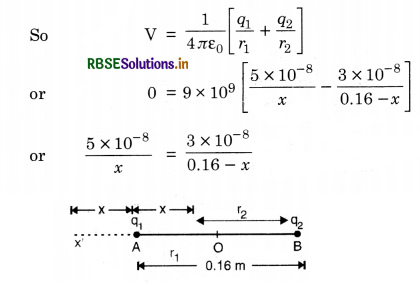
or 0.8 - 5x = 3x
or 8x = 0.8
or x = 0.1 m = 10 cm
Now let us take second case
i.e. when x' = 0.16 + x, V = 0
We have
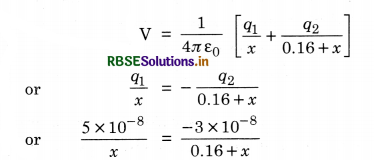
or 0.8 + 5x = 3x
2x = 0.8
or x = 0.4m = 40 cm.

Question 2.2.
A regular hexagon of side 10 cm has a charge 5 µC at each of its vertices. Calculate the potential at the centre of the hexagon.
Answer:
From the figure TBQ 2.2 we have
OP = OQ = OR = OS =OT = OU = r = 10 cm = 0.1 m
And given q = 5 µC = 5 x 10-6 C
∴ Potential at O due to all the charges
V = 6 x

or V =
= 2.7 x 106 volt
Question 2.3.
Two chrges 2 µC and -2 µC are placed at points A and B 6 cm apart.
(a) Identify an equipotential surface of the system.
(b) What is the direction of the electric field at every point on this surface?
Answer:
(a) The plane normal to AB and passing through its mid-point has zero potential everywhere hence the plane is equipotential.
(b) Normal to the plane is the direction AB.
Question 2.4.
A spherical conductor of radius 12 cm has a charge of 1.6 x 10-7 C distributed uniformly on its surface. What is the electric field
(a) inside the sphere
(b) just outside the sphere
(c) at point 18 cm from the centre of the sphere?
Answer:
(a) Zero
(Because electric field inside a conductor is always zero)
(b) E =
= 9 x 109 x
= 105 NC-1
(c) E =
or E = 9 x 109 x
= = 4.44 x 104 NC-1
Question 2.5.
A parallel plate capacitor with air between the plates has a capacitance of 8pF (1pF = 10-12 F). What will be the capacitance if the distance between the plates is reduced by half, and the space between them is filled with a substance of dielectric constant 6?
Answer:
The capacitance of capacitor with air as dielectric is given by
C =
C = 8pF = 8 x 10-12 F
∴ = 8 x 10-12 F ........................(1)
If C1 is new capacitance when d1 = and space is filled with a substance of dielectric constant K = 6, then
C1 =
or C1 =
Using Eq. (1)
C1 = 12 x 8 x 10-12 F
or C1 = 96pF

Question 2.6.
Three capacitors each of capacitors 9pF are connected in series. (a) What is the otal capacitance of the combination? (b) What is the potential difference across each capacitors, if the combination is connected to a 120 volt supply?
Answer:
Given C1 = C2 = C3 = 9pF = 9 x 10-12 F; V = 120 volt.
(a) Total capacitance of the series combination is given by
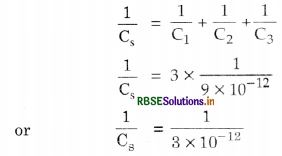
∴ Cs = 3 x 10-12 F = 3pF
(b) Let q be charge on each capacitor. Then, sum of the potential difference across their plates must be equal to 120 V
i.e. V1 + V2 + V3 = 120
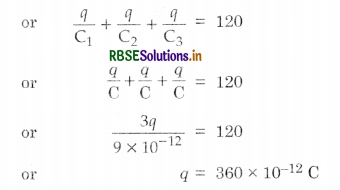
Since, all the capacitors are of the same capacitance, potential difference across a capacitor
= = 40 V
Question 2.7.
Three capacitors of capacitance 2pF, 3pF and 4pF are connected in parallel. (a) What is the total capacitance of the combination? (b) Determine the charge on each capacitor, if the combination is connected to a 100 V supply.
Answer:
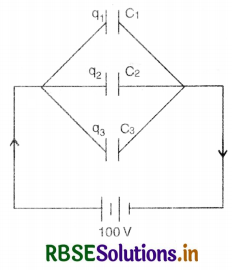
Here C1 = 2pF; C2 = 3pF; C3 = 4pF; V = 100 volt
(a) Total capacitance of the parallel combination is given by C = C1 + C2 + C3 = 2 + 3 + 4 = 9pF.
(b) Let q1, q2 and q3 be the charges on C1, C2 and C3 respectively. In the parallel combination, the potential difference across each capacitor will be equal to the supply voltage i.e. 100 V.
Therefore, q1 = C1V = 2 x 10-12 x 100
= 2 x 10-10 C,
q2 = C2V = 3 x 10-12 x 100 = 3 x 10-10 C
and q3 = C3V = 4 x 10-12 x 100 = 4 x 10-12 C.
Question 2.8.
In a parallel plate capacitor with air between the plates, each plate has an area of 6 x 10-3 m2 and the distance between the plates is 3 mm. Calculate the capacitance if this capacitor is connected to a 100 V supply, what is the charge on each plate of the capacitor?
Answer:
Given
A = 6 x 10-3 m2, d = 3 mm = 3 x 10-3 m
C0 = ?
V0 = 100 V, q = ?
Since C0 =
or C0 =
= 17.7 x 10-12 F = 18 x 10-12 F
= 18 pF
q0 = C0V = 18 x 10-12 x 100
q0 = 1.8 x 10-9 C
Question 2.9.
Explain what would happen if in the capacitor given in exercise 2.8, a 3mm thick mica sheet (of dielectric constant = 6) were inserted between the plates.
(a) While the voltage supply remained connected.
(b) After the supply was disconnected.
Answer:
(a) When supply voltage remains connected
V = 100 volts (voltage remains constant)
Capacitance C = KC0 = 6 x 18 = 108 pF
Charge q = 1.8 x 10-9 C (remains constant)
(b) After the supply is disconnected
Voltage = = 16.6 V
Capacitance, C = 108 pF (remains constant)
Charge, q = q0 = 1.8 x 10-9 (remains the same as in case (a))

Question 2.10.
A 12 pF capacitor is connected to a 50 V battery. How much electrostatic energy is stored in the capacitor?
Answer:
Given C = 12 pF = 12 x 10-12 C
V = 50 volt
Energy stored E = CV2
= x 12 x 10-12 x 2500
= 1.5 x 10-8 J.
Question 2.11.
A 600 pF capacitor is charged by a 200 V supply. It is then disconnected from the supply and is connected to another uncharged 600 pF capacitor. How much electrostatic energy is lost in the process?
Answer:
Given C1 = 600 pF = 600 x 10-12 F
V1 = 200 volt
∴ Initial energy, E1 = C1V12
= x 600 x 10-12 x 4 x 104
E1 = 12 x 10-6 J
Since C1 = C2 = 600 x 10-12 F
And q1 = C1V1 = 600 x 10-12 x 200
or q1 = 12 x 10-8 C
Common potential, V =
=
or V = 100 volt
Final energy, E2 = (C1 + C2) V2
= x 2 x 600 x 10-12 x 104
or E2 = 6 x 10-6 J
∴ Energy lost, E = E1 - E2 = 6 x 10-6 J
ADDITIONAL EXERCISES
Question 2.12.
a charge of 8 mC is located at the origin. Calculate the work done in taking a small charge of -2 x 10-9 C from a point P (0, 0, 3 cm) to a pont Q (0, 4 cm, 0) via a point R (0, 6 cm, 9 cm).
Answer:
Given
q = 8 mC = 8 x 10-3 C
q0 = -2 x 10-9 C
rP = 3 cm = 3 x 10-2 m
rQ = 4 cm = 4 x 10-2 m
Since work done in moving a charge in electrostatic field is independent of path. So the point R is irrelevant here.
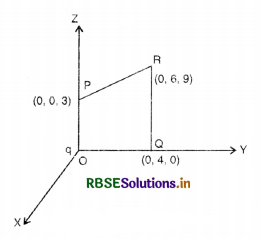
∴ Work done, W =
= 9 x 109 x 8 x 10-3 x (-2 x 10-9)
or W = -144 x 10-3 x 102
= 1.2 J
Question 2.13.
A cube of side b has a charge q at each of its vertices. Determine the potential and electric field due to this charge away at the centre of the cube.
Answer:
Let r = distance of each charge from the centre of cube.
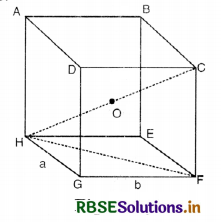
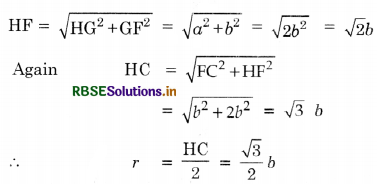
Potential at the centre O = Potential due to eight charges
or V =
or V =
Electric field inside a symmetrical surface is zero.

Question 2.14.
Two tiny spheres carrying charges of 1.5 µC and 2.5 µC are located 30 cm apart. Find the potential and electric field.
(a) at the mid-point of the line joining the two charges, and
(b) at a point 10 cm from this mid-point in a plane normal to the line and passing through the mid-point.
Answer:
(a) Potential, V =
Potential, V1 due to charge 1.5 µC at the mid-point of the line joining the two charges.
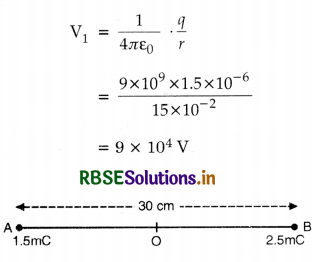
Potential, V2 due to charge 2.5 µC at the mid-point of the line joining the two charges
V2 =
= 15 x 104 V
Resultant potential = V1 + V2 = (9 x 104 + 15 x 104)
= 24 x 104 V = 2.4 x 105 V
Electric field =
Electric field, E1 due to charge 1.5 µC at the mid-point of the line joining the two charges
E1 =
= x 106 Vm-1 along OB
Electric field, E2 due to charge 2.5 µC at the mid-point of the lone joining the two charges
E2 =
= 106 Vm-1 along OA
Total electric field, E2 - E1 =
=
or E2 - E1 = 0.4 x 106 Vm-1 = 4 x 105 Vm-1
(b) Let V be potential at P
In rt. ∠ ∆AOP, AP =
= = 0.18 m
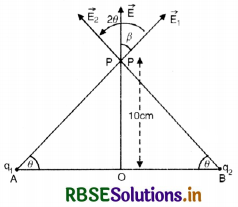
∴ Potential at P
V =
or V = 9 x 109
or V = (1.5 x 10-6 + 2.5 x 10-6)
V = 2 x 105 volt
E1 at P due to charge at A
E1 = along AP
or E1 = 4.15 x 105 Vm-1
E2 at P due to charge at B
E2 = 9 x 109 x along BP
or E2 = 6.92 x 105 Vm-1
From Fig. TBQ 2.14 (b)
cos θ =
so θ = 56.25°
∴ 2θ = 112.5°
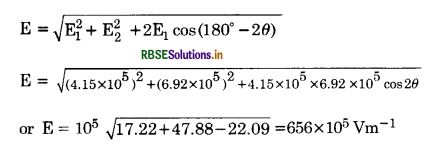
If ß is the angle between the resultant intensity E and intensity E1
tan ß =
or tan ß = = 4.2886
ß = 77°
Question 2.15.
A spherical conducting shell of inner radius r1 and outer radius r2 has a charge Q:
(a) A charge q is placed at the centre of the shell. What is the surface charge density on the inner and outer surfaces of the shell?
(b) Is the electric field in a cavity (with no charge) zero even if the shell is not spherical, but has any irregular shape? Explain.
Answer:
(a) When a charge +q is held at the centre of the shell, it will induce a charge -q on the inner surface of the shell of radius r1 and the charge +q on the outer surface of the outer shell.
∴ Surface charge density on the inner surface of shell,
σ1 =
As total charge on the outer surface of the outer shell = Q + q
∴ Surface charge density of this surface
σ2 =
(b) When the shell is not spherical and has any irregular shape, the charge inside continues to be zero as charge would always reside on the outer surface of the shell. Therefore, electric field inside cavity will remain zero.
Question 2.16.
(a) Show that the normal component of electrostatic field has a discontinuity from one side of a charged surface to another given by
where is a unit vector normal to the surface of a point and σ is the surface charge density at that point. (The direction of is from side 1 to side 2). Hence show that just outside a conductor, the electric field is
(b) Show that the tangential component of electrostatic field is continuous from one side of a charged surface to another.
[Hint: For (a) Use Gauss's law. For (b) use the fact work done by electrostatic field on a closed loop is zero.]
Answer:
(a) Let E1 and E2 be the electric fields on the two faces of charged surface. The magnitude of electric field whose direction is at angle θ with respect to the normal n to the surface,
(θ = 0°)
(b) Since work done by electrostatic field on a closed loop is zero. Hence the tangential component of electrostatic field is continuous from one side of a charged surface to another.
Question 2.17.
A long charged cylinder of linear charge density λ is surrounded by a hollow coaxial conducting cylinder. What is the electric field in the space between the two cylinders?
Answer:
Divide the cylinder into infinitesimal segments dx. The charge dq on this element dx is given by dq = λ dx so that the electric field due to this charge at P, is given by
dE =
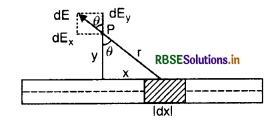
The vector dE has the components
dEx = dE sin θ
and dEy = dE cos θ
E = ∫ dEy = ∫ dE cos θ = ∫ cos θ
or E =
From the above figure
x = y tan θ
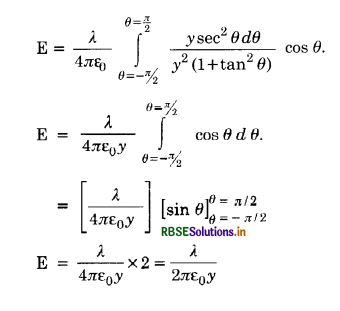
The field is radial and perpendicular to the axis.
Question 2.18.
In a hydrogen atom the electron and proton are bound at a distance of about 0.53 Å.
(a) Estimate the potential energy of the system in eV, taking to zero of potential energy at infinite separation of the electron from proton.
(b) What is the minimum work required to free the electron, given that its kinetic energy in the orbit is half the magnitude of potential energy obtained in (a)?
(c) What are the answers to (a) and (b) above if the zero of potential energy is taken at 1.06 Å separation?
Answer:
(a) Potential energy =
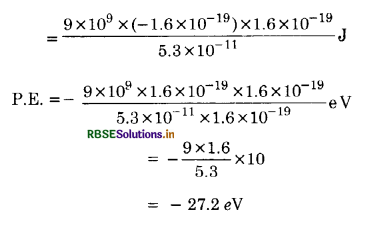
(b) K.E. = x (+27.2) = +13.6 eV
= -13.6 eV
Minimum work required to free electron
= E∞ - E1 = 0 - (-13.6) = 13.6 eV
r = 1.06 x 10-10 m
(c) P. E. =
=
= -13.6 eV
Question. 2.19.
If one of the two electrons of a H2 molecule is removed we get a hydrogen molecular ion (H+2). In the ground state of H+2 the two protons are separated by roughly 1.5 Å and the electron is roughly 1 Å from each proton. Determine the potential energy of the systems. Specify your choice of the zero of potential energy.
Answer:
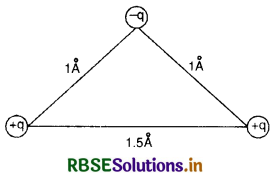
E = E12 + E13 + E23
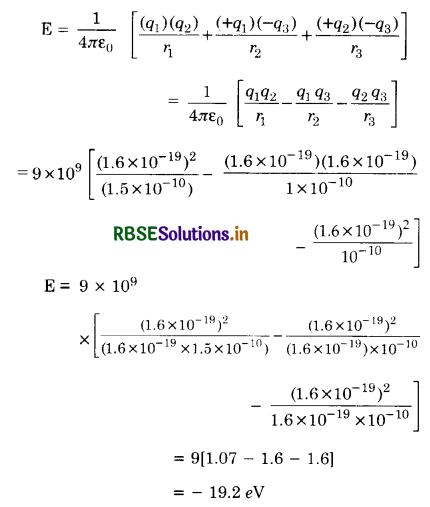
Question 2.20.
Two charged conducting spheres of radii a and b are connected to each other by a wire. What is the ratio of electric fields at the surfaces of the two spheres? Use the result obtained to explain why charge density on the sharp and pointed ends of a conductor is higher than on its flattened portions?
Answer:
Electric field of 1st spherical conductor on its surface
E1 ∝
Electric field of 2nd spherical conductor on its surface
E2 ∝
∴
Since a flat portion may be considered as a spherical surface of large radius (i.e. lower charge density, as charge density = and a pointed portion as of small radius (i.e. highest charge density)

Question 2.21.
Two charges -q and +q are located at points (0, 0, -a) and (0, 0, a) respectively:
(a) What is the electrostatic potential at the points (0, 0, z) and (x, y, 0)?
(b) Obtain the dependence of potential on the distance r of the point from the origin when >>1.
(c) How much work is done in moving a small test charge from the point (5, 0, 0) to the point (-7, 0, 0) along the x-axis? Does the answer change if the path of the test charge between the same points is not along the x-axis?
Answer:
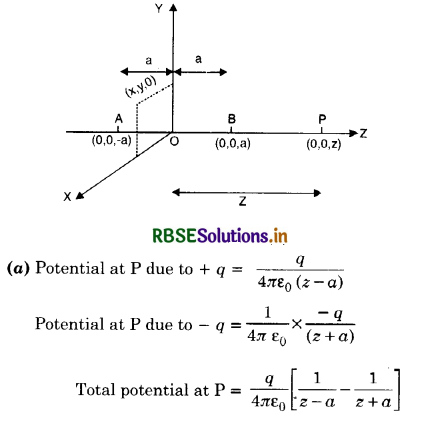
Potential =
On the axis of the dipole, potential is
[∵ p = q x 2a]
Normal to the axis at point (x, y, 0) potential is zero.
(b) Let us calculate the electric potential at any charges -q and +q at A and B respectively separated by a distance 2a from each other. Let 'r' be the distance of the point P from the centre O of the dipole and r1 and r2 be the distance of P from the centre of charges +q and -q respectively.
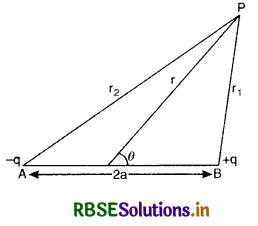
This potential at P due to the two charges is given as
V = ...................(1)
where r12 = r2 + a2 -2ar cos θ (by cosine law)
where θ is as shown in above Fig.
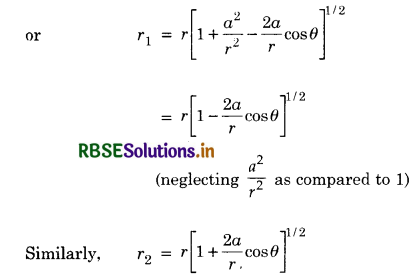
Substituting in relation (1), we have
V =
V =
(Using Binomial Theorem and neglecting higher powers of(, we get
V =
V =
(c) Since potential at any point on the axis perpendicular at axis of dipole is zero, the work done is zero. Along any other path work done will be zero because work done by electrostatic fields between two points is independent of the path connecting the two points.
Question 2.22.
Figure TBQ 2.22 shows a charge array known as an 'electric quadrupole'. For a point on the axis of the quadrupole, obtain the dependence of potential r for >>1. Contrast your result with that due to an electric dipole and on electric monopole (i.e. a single charge).

Answer:
Applying equation
V =
or V =
Given that >>1. It shows us to neglect a in the sum and difference terms in the denominator yielding.
V =
where (q = 2qa2) is the electric quadrupole moment of the charge assembly as shown in Fig. TBQ 2.22.
Thus large r, quadrupole potential goes like 1/r3.
Dipole potential goes like and monopole potential goes like .
Question 2.23.
An electrical technician requires a capacitance of 2 µF in a circuit across a potential difference of 1 k/v. A large number of 1 µF capacitor are available to him each of which can withstand a potential difference of not more than 400 V. Suggest a possible arrangement that requires a minimum number of capacitors.
Answer:
Let m = no.of rows of capacitors.
n = no.of capacitors in each row.
∴ Total no.of capacitors, N = mn.
When capacitors are connected in series n capacitors connected in a row withstand voltage equal to 400 n volts.
400 n = 103
n ≃ 3
If Cs is total capacitance in a row, then
= 3
Cs = µF
If C' is total capacitance of m rows, then
C = mCs
2 = m x
∴ m = 6
Question 2.24.
What is the area of the plates of a 2F parallel plate capacitor given that the separation between the plates is 0.5 cm? You will realize from your answer why ordinary capacitors are in the range of µF or less ? However, electrolytic capacitors do have a much larger capacitance (0.1 F) because of very minute separation between the conductors.
Answer:
C = 2F, A = ?, d = 0.5 cm = 0.5 x 10-2 m
C =
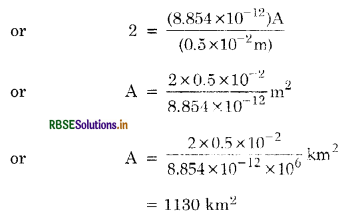

Question 2.25.
Obtain the equivalent capacitance of the following network.
For a 300 V supply, determine the charge and voltage across each capacitor.
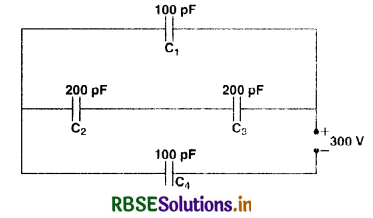
Answer:
The equivalent capacitance of the capacitors C2 and C3 in series
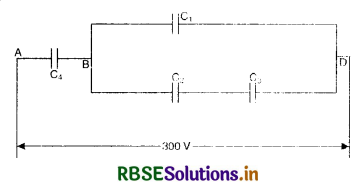
C23 = = 100 pF.
The equivalent capacitor C23 is in parallel with capacitor C of value 100 pF. Hence the equivalent capacitance of the system is
C = 100 + 100 = 200 pF.
This equivalent capacitor is in series with C4 = 100 pF capacitor. Hence the equivalent capacitance of the system is
or C = pF.
Potential difference between A and D = 300 V
This potential difference will be divided between two points A and B and B and D, in the inverse ratio of the capacitance between them
∴ P.D. between A and B = 200 V
P.D. between B and D = 100 V
So V4 = 200 V
and q4 = C4V4 = 100 x 10-12 x 200 = 2 x 10-8 C
V1 = 100 V
and q1 = C1V1 = 100 x 10-12 x 100 = 10-8 C
Since C2 and C3 are equal
So V2 = V3 = = 50 V
and q2 = q3 = C2V2 = C3V2 = 10-8 C
Question 2.26.
The plates of a parallel plate capacitor have an area of 90 cm2 each and are separated by 2.5 mm. The capacitor is charged by connecting it to a 400 V supply.
(a) How much electrostatic energy is stored by the capacitor?
(b) View this energy as stored in the electrostatic field between the plates, and obtain the energy per unit volume u. Hence arrive at a relation between u and the magnitude of electric field E between the plates.
Answer:
d = 2.5 mm = 2.5 x 10-3 m
A = 90 cm2 = 90 x 10-4 m2
Potential V = 400 volt.
(a) Electrostatic energy stored in the capacitor.
u = V2
or u =
or u = x 10-9 = 2.55 x 10-6 J
(b) Volume = A x d
= 90 x 10-4 x 2.5 x 10-3
= 255 x 10-7 m3
Energy per unit volume, u = = 0.113 Jm-3
Now u =
or u =ε0.E2.
Question 2.27.
A 4 µF capacitor is charged by a 200 V supply. It is then disconnected from the supply, and in connected to another uncharged 2 µF capacitor. How much electrostatic energy of the first capacitor is in the form of heat and electromagnetic radiation?
Answer:
Charge on the 4 µF capacitor when it is charged to 200 V.
Q = CV = (4 x 10-6 F) (200 V) = 8 x 10-4 C.
This charge on the first capacitor is now shared between the two until they attain a common potential.
The common potential after the combination
= = 1.33 x 102 V = 133 V
The electrical potential energy of the first capacitor before it is connected to the second
= CV2 = (4 x 10-6) (200)2
= 8 x 10-2 J
The electrical potential energy of the system after they are connected
= C'V'2 = (6 x 10-6) (200)2 = 5.30 x 10-2 J
Energy in the form of heat and electromagnetic radiation = (8 x 10-2 - 5.3 x 10-2) J = 2.7 x 10-2 J
Question 2.28.
Show that the force on each plate of a parallel plate capacitor has a magnitude equal to QE, where Q is the charge on the capacitor, and E is the magnitude of electric field between the plates. Explain the origin of the factor .
Answer:
Suppose we increase the separation of the plate by ∆x,
Work done (by external agency) = F.∆x ........................(1)
If u = Energy density
∴ Increase in potential energy of capacitor
= u x A x ∆x ......................(2)
Where A = area of cross-section
Comparing (1) and (2)
F = Au = ε0E2A = ε0E x A E
= σAE [∵ E = ]
or F = QE.
The physical origin of the factor in the formula lies in the fact that just outside the conductor, field is E, and inside it is zero. So the average value E/2 contributes to the force.

Question 2.29.
A spherical capacitor consists of two concentric spherical conductors, held in position by suitable insulating supports. Show that the capacitance of a spherical capacitor is given by
C =
where r1 and r2 are the radii of outer and inner spheres respectively.
Answer:
Let A and B be two concentric spherical shells of a spherical capacitor. Let r2 and r1 be their respective
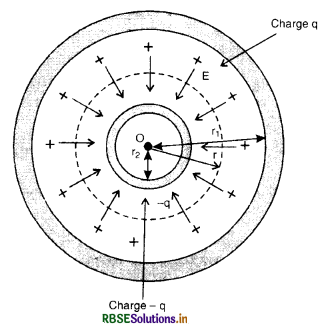
radii. Let a charge -q be given to inner shell A, so +q charge will be induced on the inner surface of shell B, whose outer surface is earthed.
Draw a Gaussian surface S of radius r and centre O between the shell A and B. The electric field inside the shell A and outside the shell B is zero.
The electric field at point P on the gaussian surface is
E = (directed inward) ..................(i)
The potential difference between two spherical shells A and B is given by:
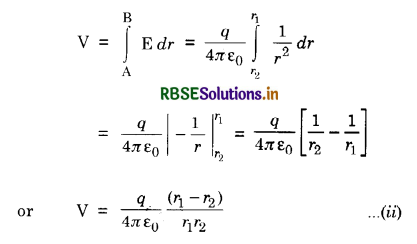
If C is the capacitance of the sphereical capacitor, then C =
Using eqn. (ii), we get
C = q = 4πε0
Question 2.30.
A spherical capacitor has an inner sphere of radius 12 cm and an outer sphere of radius 13 cm. The outer sphere is earthed and the inner sphere is given a charge of 2.5 µC. The space between the concentric sphere is filled with a liquid of dielectric constant 32.
(a) Determine the capacitance of the capacitor.
(b) What is the potential of the inner sphere?
(c) Compare the capacitance of this capacitor with that of an isolated sphere of radius 12 cm. Explain why the latter is much smaller.
Answer:
(a) The capacitance of the capacitor
C = K4πε0
K = 32
r2 = 0.12 m, r1 = 0.13 m
C = x 10-9
= 5.547 x 10-9 F.
(b) q = CV
2.5 x 10-6 = 5.547 x 10-9 x V
V =
or V = x 102 = 4.51 x 102 V.
(c) For an isolated sphere
Capacitance, C' = 4πε0 r2 = 10-11 F
= 1.33 x 10-11 F
Ratio, = 4.166 x 102 = 416
In case of spherical capacitor the indicated charge on the inner side of the outer sphere reduces the potential of the inner sphere, therefore, its capacitance is increased. This does not happen in an isolated sphere.
Question 2.31.
Answer carefully:
(a) Two large conducting shperes carrying charges of Q1 and Q2 are brought close to each other. Is the magnitude of electrostatic force bw=etween them exactly given by where r is the distance between their centres?
(b) If Coulomb's law involved 1/r3 dependence (instead of 1/r2), would Gauss's law be still true?
(c) A small test charge is released at rest at a point in an electrostatic field configuration. Will it travel along the line of force passing through that point?
(d) What is the work done by the field of a nucleus in a complete circular orbit of the electron? What if the orbit is elliptical?
(e) We know that electric field is discontinuous across the surface of a charged conductor.
(f) What meaning would you give to the capacity of single conductor?
(g) Guess a possible reason why water has a much greater dielectric constant (= 80) then say mica (= 6) ?
Answer:
(a) No, because charge distribution on the sphere will not be uniform.
(b) No, Gauss's law will not be true.
(c) Not necessarily. It is true only if the line of force is a straight line. The line of force given the direction of acceleration, not that of velocity, in general.
(d) Work done is zero. No matter what the shape of the complete orbit is, the value of work remains zero.
(e) No, potential is continuous.
(f) A single conductor is a capacitor with one of the plates at infinity.
(g) Water molecules have permanent dipole moments.
Question 2.32.
A cylindrical capacitor has two co-axial cylinders of length 15 cm and radii 1.5 cm and 1.4 cm. The outer cylinder is earthed and the inner cylinder is given a charge of 3.5 µC. Determine the capacitance of the system and the potential of the inner cylinder. Neglect effects (i.e. bending of field lines at the ends).
Answer:
C =
K = 1, = 9 x 109 Nm2 C-2
l = 15 cm = 15 x 10-2 m
If a and b are the radii, then
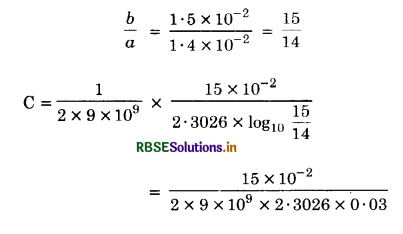
or C = x 10-9
or C = 1.21 x 10-10 F
Q = 3.5 µC = 3.5 x 10-6 C
Now V = = 2.89 x 104 V
= 2.8 x 104 V.
Question 2.33.
A parallel plate capacitor is to be designed with a voltage relating 1 kV, using a material of dielectric constant 3 and dielectric strength about 107 Vm-1 (Dielectric strength is the maximum electric field a material can tolerate without breakdown, i.e. without starting to conduct electricity through partial ionization). For safety, we should like the field never to exceed say 10% of the dielectric strength. What minimum area of the plates is required to have a capacitance of 50 pF?
Answer:
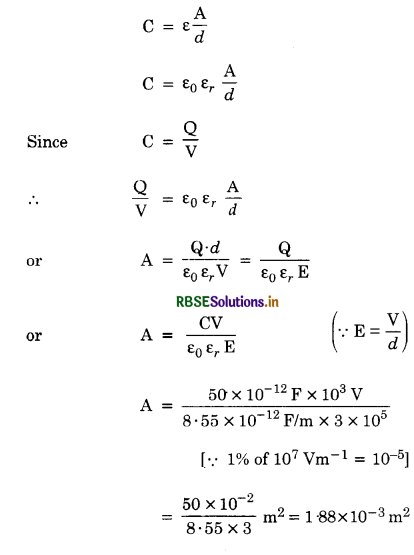
18.8 x 10-4 x 104 cm2
= 19 cm2
Question 2.34.
Describe schematically the equipotential surfaces corresponding to:
(a) a constant electric field in the z-direction.
(b) a field that uniformly increases in magnitude but remains in a constant (say z) direction.
(c) a single positive charge at the origin.
(d) a uniform grid consisting of long equally spaced paralleled charged wires in a plane.
Answer:
(a) Planes are parallel to x-y plane.
(b) Planes are parallel to x-y plane, but planes differing by a fixed potential get closer as field increases.
(c) Concentric sphere centered at the origin,
(d) A periodically varying shape near the grid which gradually reaches the shape of planes parallel to the grid at far distances.
Question 2.35.
In a Van de Graaff-type generator, a spherical metal shell is to be a 15 x 106 V electrode. The dielectric strength of the gas surrounding the electrode is 5 x 107 Vm-1. What is the minimum radius of the spherical shell required?
(You will learn from this exercise why one cannot build an electrostatic generator using a very small shell which requires a small charge to acquire a high potential?)
Answer:
V = Ed = ER
E = 5 x 107 Vm-1
R = ?
V = 15 x 106 V.
R = = 3 x 10-1 m = 30 cm
Question 2.36.
A small sphere of radius r1 and charge q1 is enclosed by a spherical shell of radius r2 and charge q2. Show that if q1 is positive, charge will necessarily flow from the sphere to the shell (when the two are connected by a wire) no matter what the charge q2 on the shell is.
Answer:
By Gauss's law, field between the sphere and shell is determined by q1 alone. Hence potential difference between the sphere and the shell is independent of q2. If q1 is positive, this potential difference is always positive and therefore charge will necessarily flow from the sphere to the shell.

Question 2.37.
Answer the following:
(a) The top of the atmosphere is at about 400 kV with respect to the surfeace of the earth, corresponding to an electric field that decreases with altitude. Near the surface of the earth, the field is about 100 Vm-1. Why then do we not get an electric shock as we step out of the house into the open? (Assume the house to be steel cage so there is no field inside!)
(b) A man fixes outside his house one evening a two-meter high insulating slab carrying on its top a large aluminum sheet of area 1 m2. Will he get an electric shock if he touches the metal sheet next morning?
(c) The discharging current in the atmosphere due to the small conductivity of air is known to be 1800 A on an average over the globe. Why then does the atmosphere not discharge itself completely in due course and become electrically neutral? In other words, what keeps the atmosphere charged?
(d) What are the forms of energy into which the electric energy of the atmosphere is dissipated during lightning?
(Hint: The earth has an electric field of about 100 Vm-1 at its surface in the downward direction, corresponding to a surface charge density = -10-9 C m-2. Due to the slight conductivity of the atmosphere up to about 50 km (beyond which it is good conductor), about +1800 C is pumped every second into the earth as a whole. The earth, however, does not get discharged since thunderstorms and dlightning occur continually all over the globe pump on equal amount of negative charge on the earth.)
Answer:
(a) Our body and ground form an equipotential surface. As we step out into the open, the original equi[otential surface of open-air changes, keeping our head and the ground at the same potential.
(b) Yes. The steady discharging current in the atmosphere charges up the aluminum sheet gradually and raises its voltage to an extent depending on the capacitance of the capacitor (formed by the sheet, slab and the ground).
(c) The atmosphere is continually being charged by thunderstorms and lightning all over the globe and discharged through regions of ordinary weather. The two opposing currents are, on an average, keep the system balanced.
(d) The electric energy of the atmosphere during lightning dissipated in the form of heat and sound energy.
SELECTED EXEMPLAR PROBLEMS
MCQ I (with one correct option)
Question 2.1.
A capacitor of 4 µF is connected as shown in the circuit. The amount of charge on the capacitor plates will be:
(a) 0
(b) 4 µC
(c) 16 µC
(d) 8 µC
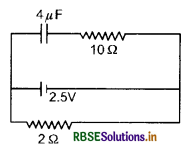
Answer:
(d) Here I = = 1A
And V = E - Ir = 2.5 - 1 x 0.5 = 2V
q = CV = 4 x 2 = 8 µC
Question 2.2.
A positively charged particle is released from rest in an uniform electric field. The electric potential energy of the charge:
(a) remains a constant because the electric field is uniform
(b) increases because the charge moves along the electric field
(c) decreases because the charge moves along the electric field
(d) decrease because the charge moves opposite to the electric field.
Answer:
(c) The charge moves from higher to lower potential.
Question 2.3.
Fig EP 2.3 shows some equipotential lines distributed in space. A charged object is moved from point A to point B.
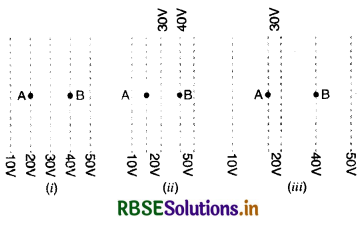
(a) The work done in Fig. EP 2.3 (i) is the greatest.
(b) The work done in Fig. EP (ii) is least.
(c) The work done is the same in Fig. EP 2.3 (i), Fig. (ii) and Fig. EP 2.3 (iii).
(d) The work done in Fig. EP 2.3 (iii) is greater than Fig. EP 2.3 (iii) is greater than Fig. EP 2.3 (ii) but equal to that in Fig. EP 2.3 (i).
Answer:
(c) Since work done W = q (VB - VA) = q (40 - 20)
= 20q J.
Question 2.4.
The electrostatic potential on the surface of a charged conducting sphere is 100V.
S1: AT any point inside the sphere, electric intensity is zero.
S2: At any point inside the sphere, the electrostatic potential is 100V.
Which of the following is a correct statement?
(a) S1 is true but S2 is false.
(b) Both S1 & S2 are false.
(c) S1 is true, S2 is also true and S1 is the cause of S2.
(d) S1 is true, S2 is also true but the statements are independent.
Answer:
(c) Since E = 0 inside a conductor
and - = E = 0
or V = constant

Question 2.5.
Equipotentials at a great distance from a collection of charges whose total sum is not zero are approximately
(a) spheres
(b) planes
(c) paraboloids
(d) ellipsoids.
Answer:
(a) because electric field due to a collection of charges whose total sum is not zero is spherical symmetric about the charge.
Question 2.6.
A parallel plate capacitor is made of two dielectric blocks in series. One of the blocks has thickness d1 and dielectric constant k1 and the other has thickness d2 and dielectric constant k2 as shown in Fig. EP 2.6. This arrangement can be thought as a dielectric slab of thickness d (=d1 + d2) and effective dielectric constant k. The k is:
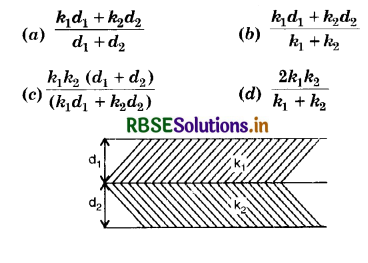
Answer:
(c) C1 = , C2 =
When both the capacitors are connected in series
C =
Or k =
MCQ II (with more than one correct options)
Question 2.7.
Consider a uniform electric field in the z-direction. The potential is a constant:
(a) in all space.
(b) for any x for a given z.
(c) for any y for a given z.
(d) on the x-y plane for a given z.
Answer:
(b), (c), (d). Here E is along z-axis, so equipotential surface S are along x-y plane.
Question 2.8.
Equipotential surfaces:
(a) are closer in regions of large electric fields as compared to regions of lower electric fields.
(b) will be more crowded near sharp edges of a conductor.
(c) will be more crowded near regions of large charge densities.
(d) will always be equally spaced.
Answer:
(a), (b), (c). Since dr ∝
Question 2.9.
The work done to move a charge along an equipotential from A to B
(a) cannot be defined as -
(b) must be defined -
(c) is zero.
(d) can have non-zero value.
Answer:
(b), (c). As W = -
For equipotential surface
So W = = 0 [∵ = 0 for ]
Question 2.10.
In a region of constant potential
(a) the electric field is uniform
(b) the electric field is zero
(c) there can be no charge inside the region
(d) the electric field shall necessarily change if a charge is placed outside the region.
Answer:
(b), (c)
Because for constant potential
E = - = 0
And q = ε0 = 0 [∵ E = 0]

Question 2.11.
In the circuit shown in Fig. EP 2.11 initially key K1 is closed and key K2 is open. Then K1 is opened and K2 is closed (order is important). [Take Q1' and Q2' as charges on C1 and C2 and V1 and V2 as voltage respectively.]
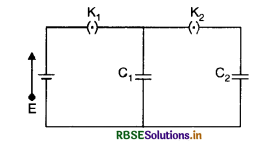
Then
(a) charge on C1 gets redistributed such that V1 = V2
(b) charge on C1 gets redistributed such that Q1' = Q2'
(c) charge pm C1 gets redistributed such that C1V1 + C2V2 = C1E
(d) charge on C1 gets redistributed such that Q1' + Q2' = Q
Answer:
(a), (d), when K1 is closed and K2 is open, then charge on C1, q = C1E
When K1 is open and K2 closed, battery is cut off. Now C1 and C2 are in parallel so the charge on C is shared between C1 and C2, s.t. V1 = V2
Since there is no loss of charge, so Q1' + Q2' = Q
Question 2.12.
If a conductor has a potential V ≠ 0 and there are no charges anywhere else outside, then
(a) there must be charges on the surface or inside itself.
(b) there cannot be any charge in the body of the conductor.
(c) there must be charges only on the surface.
(d) there must be charges inside the surface.
Answer:
(b), (d). From the knowledge of theory, the charge is distributed only on the surface of the conductor and no charge inside the conductor.

Question 2.13.
A parallel plate capacitor is connected to a battery as shown in Fig. EP 2.13.
(A) key K is kept closed and the plates of the capacitor are moved apart using insulating handle.
(B) Key K is opened and plates of capacitors are moved apart using insulating handle.
Choose the correct option(s)
(a) In A : Q remains the same but C changes
(b) In B : V remains the same but C changes
(c) In A : V remains the same and hence Q changes
(d) In B : Q remains the same and hence V changes
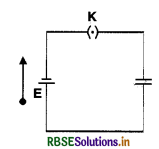
Answer:
(c), (d)
In A : Since Q = CE = E
As d is increased, Q decreases
In B : V =
As plates of capacitors are moved apart, C decreases hence V increases.
Very Short Answer Type Questions
Question 2.14.
Consider two conducting spheres of radii R1 and R2 with R1 > R2. If the two are at the same potential, the larger sphere has more charge than the smaller sphere. State whether the charge density of the smaller sphere is more or less than that of the larger one.
Answer:
Given V1 = V2
∴
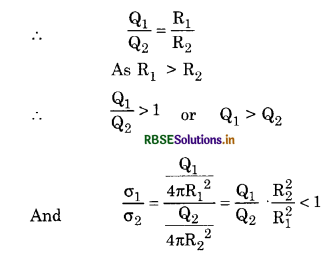
or σ1 < σ2
or σ2 > σ1
i.e. charge density of smaller sphere is more than charge density of larger sphere.
Question 2.15.
Do free electrons travel to regions of higher potential or lower potential?
Answer:
Electrons possess negative charge so they move to regions of higher potential.
Question 2.16.
Can there be a potential difference between two adjacent conductors carrying the same charge?
Answer:
Yes, because potential V = , and if two conductors are of different sizes, their capacitance will also be different.
Question 2.17.
Can the potential function have a maximum or minimum in free space?
Answer:
No, because E = -
If V is maximum or minimum
E = 0

Question 2.18.
A test charge q is made to move in the electric field of a point charge Q along two different closed paths ( Fig. EP 2.18). First path has sections along and perpendicular to lines of electric field. Seconf path is a rectangular loop of the same area as the first loop. How does the work done compare in the two cases?
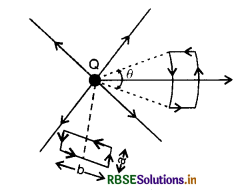
Answer:
We know that electric field is conservative in nature, so work done will be zero in both the cases.
Short Answer Type Questions
Question 2.19.
Prove that a closed equipotential surface with no charge within itself must enclose an equipotential volume.
Answer:
Let it does not enclose an equipotential volum, then the potential just inside the surface would be different from that at the surface would be different from that at the surface resulting in a potential gradient. So there would be electric field lines poiniting inwards or outwards from the surface. These lines cannot at the other end of the lines has greater charges inside. As there is no charge inside so the entire volume inside must be at the same potential.
Question 2.20.
A capacitor has some dielectric between its plates, and the capacitor is connected to a DC source. The battery is now disconnected and then the dielectric is removed. State whether the capacitance, the energy stored in it, electric field, charge stored and the voltage will increase, decrease or remain constant.
Answer:
Since capacitance C = KC0 [C0 is the capacitance without dielectric].
When dielectric is removed, C will decrease energy stored U = will increase.
Potential (V) will increase, electric field E = will increase.

Question 2.21.
Prove that, if an insulated, uncharged conductor is placed near a charged conductor and no other conductors are present, the uncharged body must be intermediate in potential between that of the charged body and that of infinity.
Answer:
When an insulated, uncharged conductor is placed near a charged conductor, induced charges will be acquired by uncharged conductor. The potential will be acquired by uncharged conductor. The potential will decrease along a path from a charged conductor to uncharged conductor. Since potential at infinity is zero, it means that the uncharged body must be intermediate in potential between the uncharged body and that at infinity.
Long Answer Type Questions
Question 2.24.
Find the equation of the equipotentials for an infinite cylinder of radius r0, carrying charge of linear density λ.
Answer:
Consider a cylinder of radius r0 having uniform linear charge density λ. The electric lines are all radially outward. Let us find electric field intensity at point P. Draw a cylindrical Gaussian surface of radius r and length l as shown in the Fig. EP 2.24.
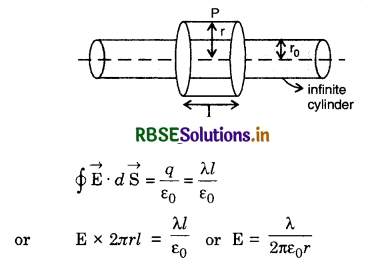
Now dV = V(r) - V(0) = -
For an equipotential surface of given V(r)
(V(r) - V(0))
r = r0 e [V(r) - V(0)]
This is the required equation
Question 2.25.
Two point charges of magnitude +q and -q are placed at (-d/2, 0, 0) and (d/2, 0, 0), respectively. Find the equation of the equipotential surface where the potential is zero.
Answer:
Two point charges +q and -q are lying at points A and B with centre O as shown in the figure. Let equipotential surface with V = 0 be at a distance x from O. Let us find potential at P at a distance h from AB.
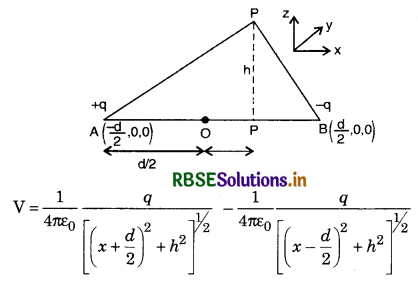
If V = 0, then
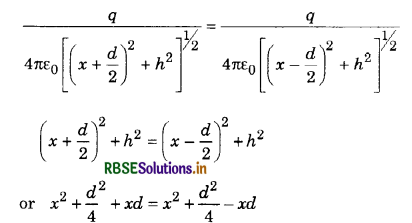
or 2 x d = 0
or x = 0 is the equation of surface where potential is zero.
Question 2.26.
A parallel plate capacitor is filled by a dielectric whose relative permittivity varies with the applied voltage (U) as ε = αU where α = 2V-1. A similar capacitor with no dielectric is charged to U0 = 78 V. It is then connected to the uncharged capacitor with the dielectric. Find the final voltage on the capacitors.
Answer:
When the two capacitors are connected, the final voltage be U. Charge on the capacitor without dielectric Q1 = CU.
Charge on the capacitor (without capacitance) was Q0 = CU0. Then from the law of conservation of charges, we have
Q0 = Q1 + Q2
or CU0 = CU + αCU2
or αU2 + U - U0 = 0
or U =
=
or U = 6 V or -6.5 V
As U is positive
So U = 6 volt
Question 2.27.
A capacitor is made of two circular plates of radius R each, separated by a distance d <<R. The capacitor is connected to a constant voltage. A thin conducting disc of radius r <<R and thickness t <<r is placed at a center of the bottom plate. Find the minimum voltage required to lift the disc if the mass of the disc is m.
Answer:
When the disc is placed at the center of the bottom plate, the disc is in touch with the bottom plate and thus, charge transferred to the disc is:
q' = CV = πr2
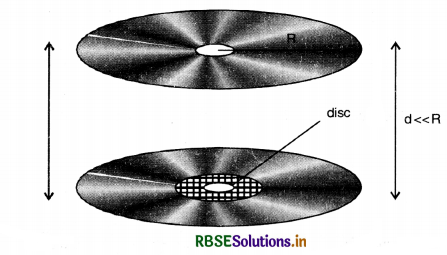
Force on the disc
F = -q'E = -qπr2
If the disc is to be lifted, then
F ≥, mg
or πr2 = mg
or V =

Question 2.28.
Two metal spheres, one of radius R and the other of radius 2R, both have the same surface charge density s. They are brought in contact and separated. What will be new surface charge densities on them?
Answer:
Before contact, charges on two spheres q1 = s 4πR2 and q2 = s π(2R)2 = 4(s4πR2) = 4q1
After contact, charges on two spheres
q1' + q2' = q1 + q2 = q1 + 4q1 = 5q1 = 5(s4πR2)
When two charges are in contact, their potential will be equal.
i.e.
or q2' = 2q1'
As there is no loss of charge, so
q1' + q2' = q1 + q2
or q1 + 2q1' = q1 + 4q1
or q1' = q1 = (s 4πR2) and q2' = 2q1 = (s 4πR2)
or σ1 = s and σ2 = s
Question 2.29.
In the circuit shown in Fig. EP 2.29 initially K1 is closed and K2 is open. What are the charges on each capacitors.
Then K1 was opened and K2 was closed on each capacitor now? [C = 1 µF]
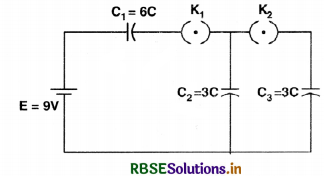
Answer:
(i) When K1 is closed and K2 is open, the capacitor C3 is not in the circuit, So Q3 = 0.
Cs = = 2 µF
∴ Q1 = Cs.E = 2 x 9 = 18 µC and
Q2 = Cs.E = 2 x 9 = 18 µC.
(ii) When K1 is open an dK2 is closed, charge Q1 remains the same i.e. Q1' = Q1 = 18 µC.
Now the charge will be shared between C2 and C3. As C2 = C3 are parallel, so charge is equally divided on C2 and C3
∴ Q2' = Q3' = = 9 µC.

Question 2.30.
Two charges -q each are separated by distance 2d. A third charge +q is kept at mid-point O. Find potential energy of +q as a funciton of small distance x from O due to -q charges. Sketch P.E. v/s x and convince yourself that the charge at O is in an unstable equilibrium.
Answer:
From Fig EP 2.30. (a), we find that +q charge be placed at p at a distance x from O (mid-point). So the potential energy of +q charge at P is
U = .............(i)
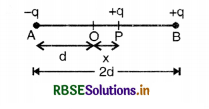
Fig. EP 2.30 (b) shows the variation of potential energy with x
At x = 0, eqn.(i) becomes U =
So, = 0. It means that at x = 0, q charge is in equilibrium.
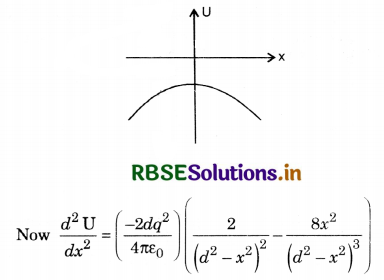
=
At x =0, < 0
Hence, the equilibrium of charge q at P is unstable.

- RBSE Class 12 Physics Notes Chapter 2 स्थिर वैद्युत विभव तथा धारिता
- RBSE Class 12 Physics Notes Chapter 3 विद्युत धारा
- RBSE Class 12 Physics Notes Chapter 4 गतिमान आवेश और चुंबकत्व
- RBSE Class 12 Physics Notes Chapter 5 चुंबकत्व एवं द्रव्य
- RBSE Class 12 Physics Notes Chapter 6 वैद्युत चुंबकीय प्रेरण
- RBSE Class 12 Physics Notes Chapter 7 प्रत्यावर्ती धारा
- RBSE Class 12 Physics Notes Chapter 8 वैद्युतचुंबकीय तरंगें
- RBSE Class 12 Physics Notes Chapter 9 किरण प्रकाशिकी एवं प्रकाशिक यंत्र
- RBSE Class 12 Physics Notes Chapter 10 तरंग-प्रकाशिकी
- RBSE Class 12 Physics Notes Chapter 11 विकिरण तथा द्रव्य की द्वैत प्रकृति
- RBSE Class 12 Physics Notes Chapter 12 परमाणु